This Naseby family’s late-season peonies are enjoyed all over the world
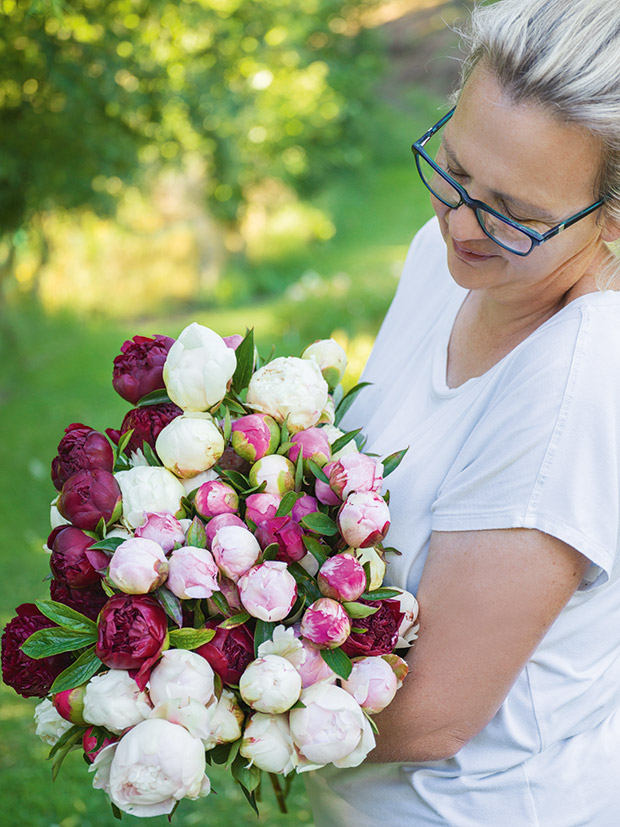
Jayne Hazlett cradles a mixed peony bunch — each family member has a favourite bloom.
An export peony business in Naseby delivers floral cheer to the likes of Hollywood royalty and familial riches to its multi-generational ranks.
Words: Claire Finlayson Photos: Rachael McKenna
When Maddie Hazlett scrutinizes Instagram photos of Hollywood A-lister weddings, she’s only doing so for horticultural reasons. It’s peonies she’s looking for — specifically, those grown in the paddocks of the multi-generational family business, Altitude Peonies, that her grandparents run in the small Central Otago town of Naseby.
This floral sleuthing is purely to quench her curiosity. Once Altitude Peonies leave their Naseby birthplace in chilled boxes, an Auckland exporter sends them on to far-flung, high-profile places. Maddie occasionally gets wind of where the blooms end up (the White House, a Milan fashion show, a sheikh’s wedding, the home of former British Prime Minister Tony Blair, and the glitzy milieu of a fair few Hollywood movie stars).
But she hasn’t a clue who’s ogling their flowers the rest of the time. Maddie wishes they had a cunning tracking device. “When you see a bunch of peonies in the back corner of a magazine photo, you think, ‘they could be ours’. We should put a red dot on them, so we would know for sure.”
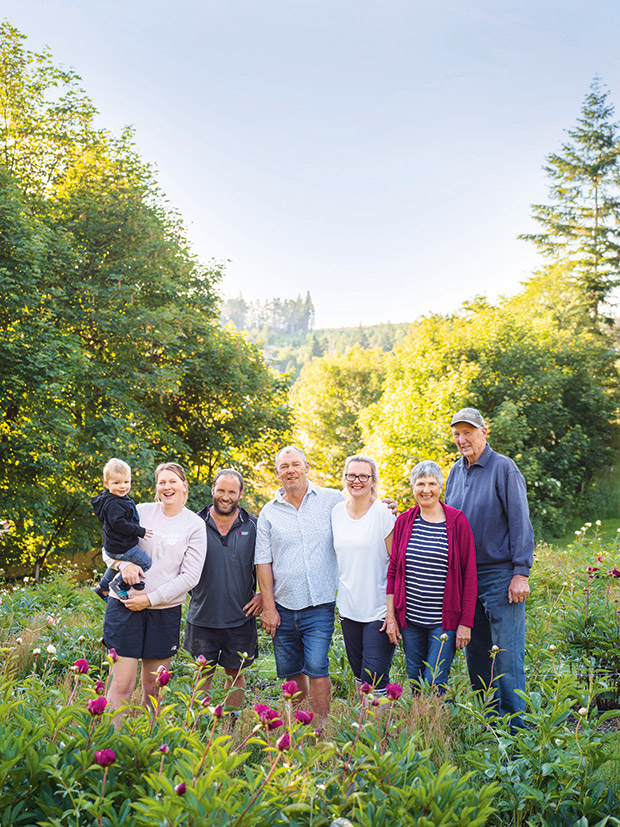
The Smith-Hazlett clan: Maddie Hazlett (holding son Braxton and pregnant with daughter Lola) and her partner Dean, James and Jayne Hazlett, Jill and John Smith.
When Maddie’s grandparents, John and Jill Smith, started growing peonies in 2000, it was with this export market in mind. They realized that northern hemisphere peonies are all fast asleep during the lucrative Christmas/New Year period, so anyone on that side of the world wanting the prized blooms for festive functions must look further afield for supply.
Even within the New Zealand growing scene, Naseby peonies get the lucky-last harvest. This is due to frigid winter temperatures and the area’s high altitude. While growers further north start picking in October, the first Altitude Peonies aren’t ready until late November. Says Jill: “Our timing is the only reason we grow peonies here. We have a real niche market. But it’s a risky one with late frosts and snowfalls.”
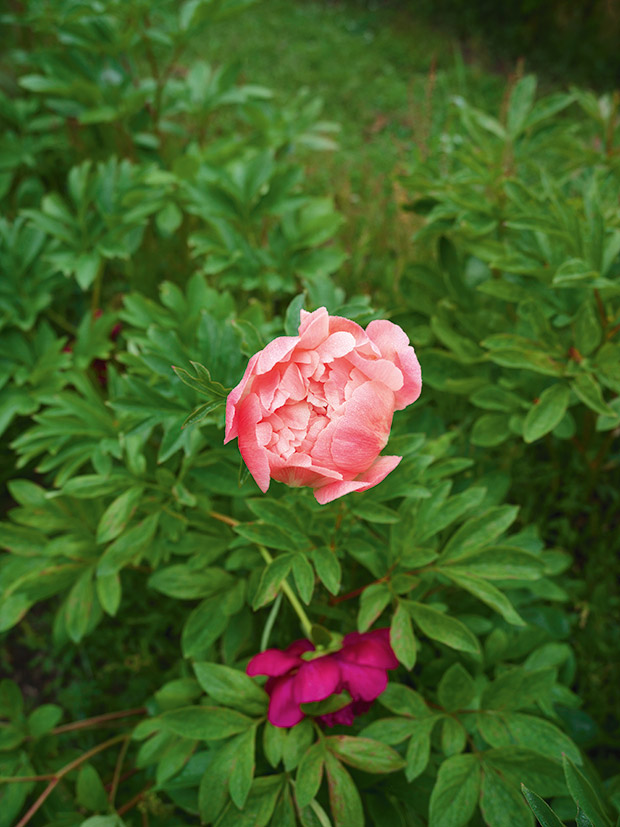
‘Coral Sunset’. The family grows 10 varieties of peonies with six main sellers. These are sorted into four grades. Most are reserved for export; others are sent to a Wellington market. Some are sold locally in Ranfurly and named ‘Charlotte’ grade for James and Jayne’s youngest daughter, who used to sit on the roadside and sell the flowers when she was just four. The ‘over the bank’ grade are the peonies that Jill picks for herself.
The cool Central Otago climate is perfect for this hardy bloom. Peonies need a pronounced period of single-digit temperatures on the ground above the tuber to flourish — and Naseby is always happy to oblige. Jayne Hazlett (John and Jill’s daughter and Maddie’s mum) says: “Our peonies probably get colder than any others in New Zealand. They get so cold that we’re known for our clean and vibrant colours. Our whites are crisp white, and our reds are really red.”
When the Smiths put down their first tubers in 2000, it was the perfect project for a newly retired John and a horticulture-keen Jill. “Someone gave a talk at our garden club and encouraged people to grow peonies,” says Jill. “We thought, ‘Oh well, let’s plant a few.’”
As it was early days for the local peony-growing scene, it was difficult to source enough tubers locally, so they imported some from Holland. It took a good four years for the plants to mature, and they didn’t start exporting until 2007 (this was in partnership with other Maniototo growers — two of whom, Naseby couple John and Jacquie Crawford, still grow blooms in association with them).
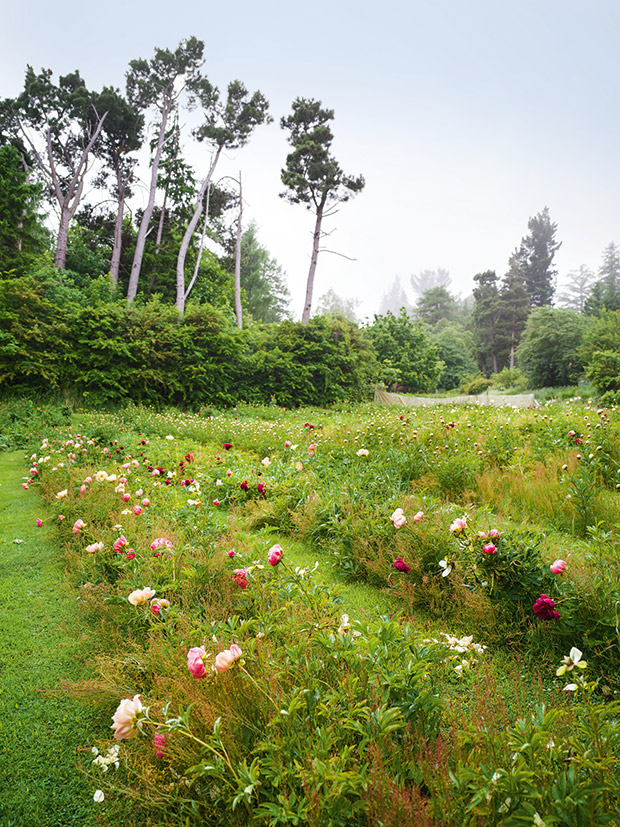
Jayne on the peony’s rugged lot: “We don’t have soil here, really. This is goldmining/sluicing country so our peonies are dug into the rock, and are frozen and snowed on. That’s why we use fertilizers and organic feed.”
The Smiths didn’t mind that peony lag time. It was a welcome boon to John’s whitebait habit. When he retired from farming sheep with his brother in nearby Kyeburn, John was 50 and knew exactly what he wanted to do. “We had two daughters, my brother had sons, and none of them was interested in farming. We thought, ‘You only get one whack at life, so why not do what you want?’ And I wanted to go whitebaiting.”
Jayne and Maddie, who’ll soon be taking over the peony business, feel a creeping dread when the whitebait season looms. For them, it means a high-stakes flower-minding gig during the mercurial transition from winter to spring when the two most peony-savvy family members are a good 700 kilometres away absorbed in matters aquatic.
“Mum and Dad disappear whitebaiting in Karamea from August through to October. There’s been many a panicked phone call to the West Coast or photos of snow sent through. Mum usually replies: ‘Oh, you’ll be all right.’ Maddie adds. “Or she doesn’t answer our calls.” Jill grins at this and says something about regrettably minimal phone coverage.
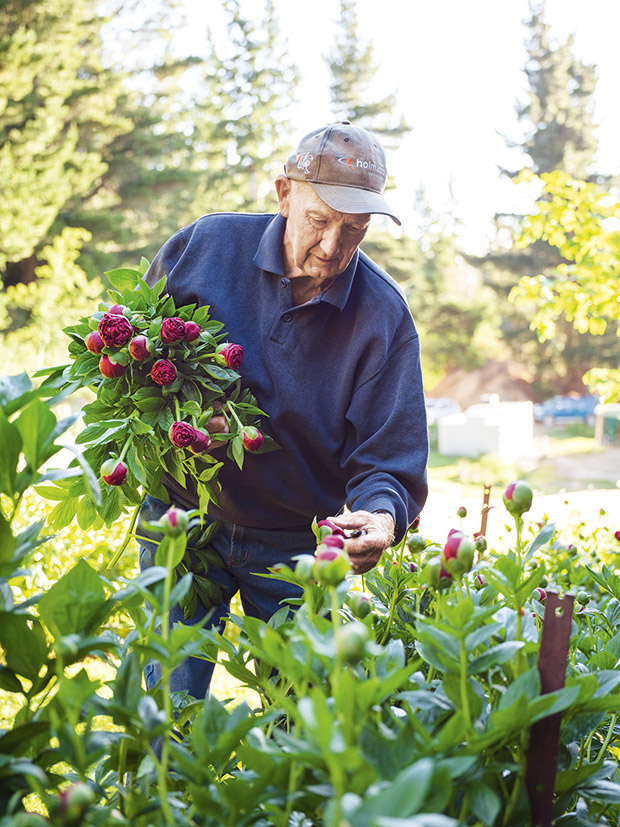
John and Jill are still outrageously conscientious workers. “We have to make Dad go home,” says Jayne.
But these grandparents are supposed to be retired. Right? “Yes,” says Maddie. “But Poppa makes me exhausted with the amount of work he does.” Jayne adds: “They won’t slow down. Mum has a great overview of everything. She remembers what we did the previous year. Dad’s coming up 82, and he’s still our chief picker. He’s also a packer, mower, sprayer and feeder.” John sums up his distinguished status as “general dogsbody”.
That general dogsbody is also a bit of a peony whisperer. There’s a fine art to picking these flowers: too early, and they won’t open; too late, and they won’t travel well. And, unhelpfully, there’s no one-size-fits-all rule for judging peony readiness.
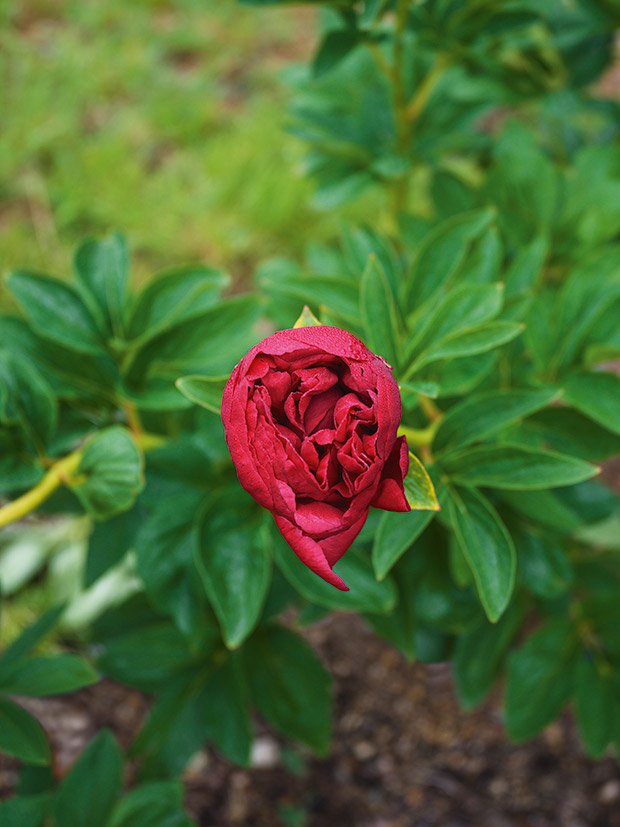
‘Henry Bockstoce’.
“You either have an eye for it, or you haven’t,” says Jill. John apparently only needs to look at ‘Bowl of Cream’ to tell if it’s ready, and he has a special knack with the fickle ‘Henry Bockstoce’ variety. “We all hate picking ‘Henrys’, except Dad,” Jayne says.
“You must have a good eye to see the colour change or smallest lift in a petal. Mum and I can stand looking at one head for ages debating if it’s ready and pick 50 or so from a row. Then Dad will come along and pick another 100. We call them ‘Dad’s Henrys’.”
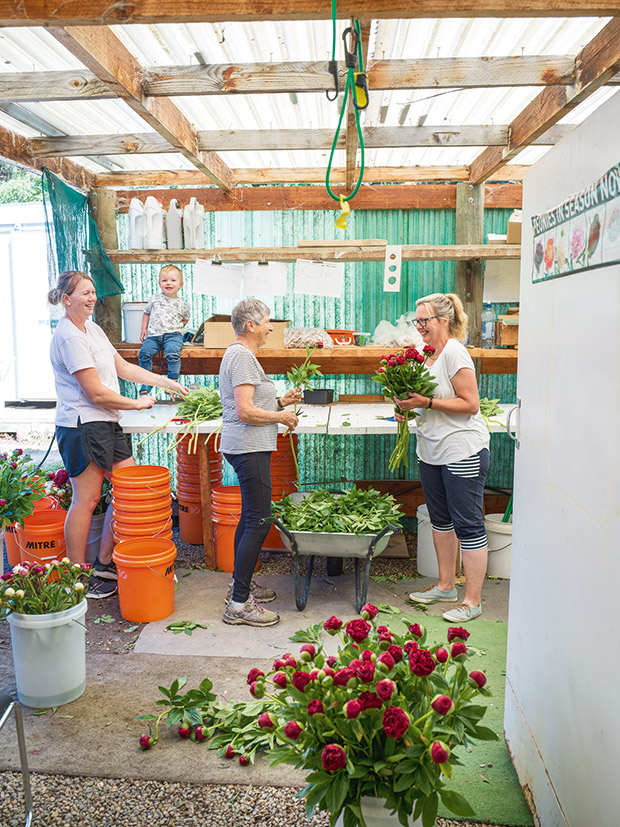
The packhouse shifts are long but leavened by much multi-generational banter and fun.
Come harvest time, and the multi-generational Smith-Hazlett clan braces itself for an intense six weeks of wrangling peonies. Jayne, who teaches at a Ranfurly Primary School, plays a pivotal role (when she’s not called out on St John ambulance duty). Husband James, the owner of Hazlett Contracting and therefore the ideal son-in-law for those with peony-paddock earthwork needs, joins the packhouse crew in the evenings (unless there’s a local fire or medical emergency.
He’s Ranfurly’s chief fire officer and a first responder for St John.) And any available offspring also pitch in (especially Maddie, who rears calves and children and works in a café in Ranfurly when not presiding over the packhouse).
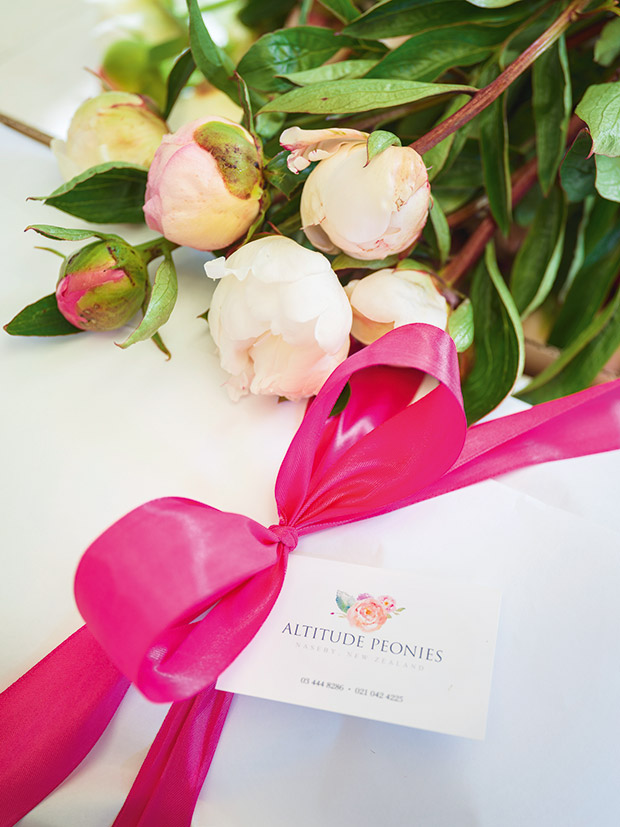
“Thinking back through the past 20 years, every one of our three daughters has worked in the packhouse,” says Jayne. “We have fond memories of our eldest daughter Charlotte dead-heading peonies for us when she was about seven. She went and chopped off the very expensive ‘Old Faithful’ buds that hadn’t yet opened.”
Altitude Peonies was only ever intended as a way of buttressing the dreams of the Smith progeny. “We did it for the grandchildren, really — to help pay for their education,” says Jill. These days, there are great-grandchildren in the mix, too. Maddie says her two-year-old son Braxton is muscling in on all the action. “He has to have his own cutters and likes to go on the tractor with Poppa.”
Jayne would love this peony dynasty to continue: “It’s fun to look at that succession. I hope to still do the same thing at Mum and Dad’s age with Maddie and her kids.”
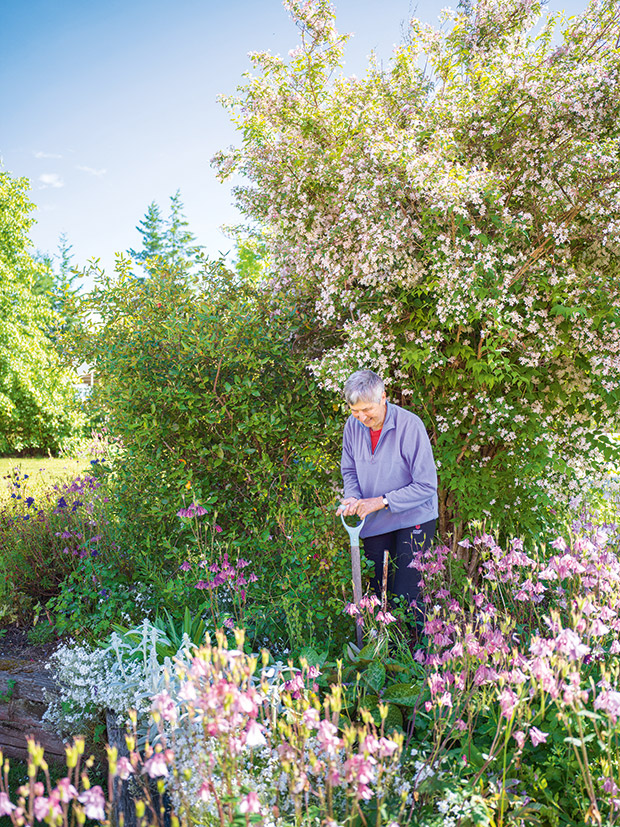
When asked what the most rewarding part of their peony venture has been, John has one emphatic word: “Family.” Financial rewards have always been secondary. “As I said at my 80th birthday party, I’m a very rich man. I have a family.”
Jayne thinks these flowers have been the perfect family glue: “We wouldn’t have the absolute joys of being together as a family without the peonies. I don’t think you can put a monetary value on family time and memories. Watching Braxton snipping things with his cutters — that’s the real joy.”
Well, until he snips an ‘Old Faithful’ or two.
PEONY TIPS FROM THE SMITH-HAZLETT CLAN
Planting: Peonies grow and flower best in full sun but will tolerate some light afternoon shade. Deep, fertile soil is best, but they can still do well in relatively poor soil if it is well-drained and fertilized.
Allow an area of one square metre when fully grown/mature (i.e., about three years). Peonies resent trees, shrubs, or even overhanging branches too close to them, which is probably the most common reason for their failure to thrive. Plant the buds upwards at a depth of five centimetres, no deeper.
General care: Cultivation is probably the best form of weed control. You can use bark mulch, but straw and compost may increase the risk of botrytis (grey mould). This can be sprayed with a fungicide in the spring.
A general garden fertilizer may improve the colour and size of blooms but avoid excessive nitrogen, which may increase susceptibility to fungal disease. Fertilizers high in phosphate and potassium and low in nitrogen are most suitable. We use a potato fertilizer.
Blooms: Herbaceous peonies die down every autumn. Different varieties pop up through the ground in spring at different times. Don’t panic if one type is three or four weeks later than another, and don’t expect too much in the first year.
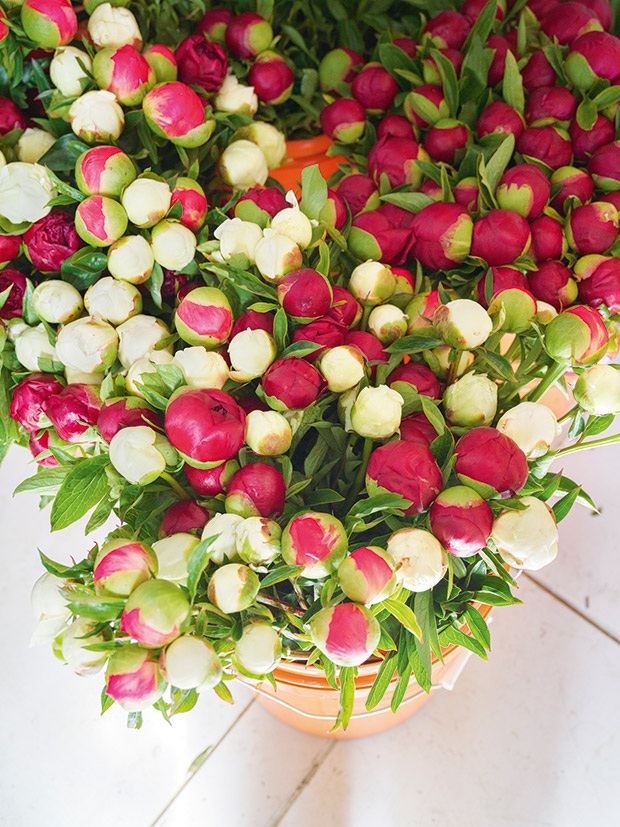
There may be only one or two stems, and the flowers may be absent, small or atypical. In the first year, don’t cut the stem off for cut flowers (stems do not regrow during the season, and the leaves are required for building up strength for the following year).
Never cut the foliage down after blooming but leave it until it turns colour in the autumn. Then cut it down to about five centimetres above ground level and remove any foliage on the ground as this may help prevent the carry-over of some fungal infections.
Love this story? Subscribe now!
 This article first appeared in NZ Life & Leisure Magazine.
This article first appeared in NZ Life & Leisure Magazine.
